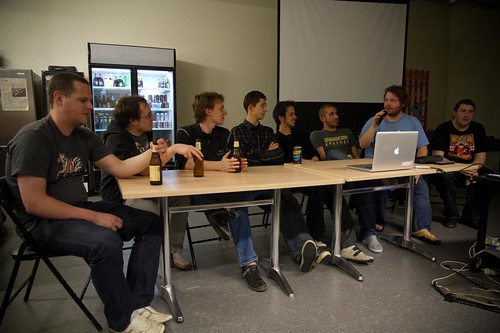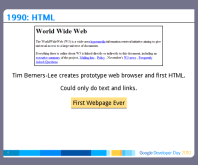As part of GDD Tokyo last week, I gave a talk on Google's "client-side Web APIs". That phrase is a bit of a mouthful (and not a common one), so here's what I mean by it: An "API" is a way for one piece of software to interact with another piece of software, a "Web API" is a way for one website to interact with another website, and a "client-side Web API" allows a website to interact with another website purely using client-side technology. For example, Google's client-side Web APIs include the Charts API (image-based), the AJAX Search APIs (JavaScript-based) and the Gadgets API (iframe-based).
Both because I needed a way to explain the underlying technology behind our APIs and because I found it interesting, I started that talk with an intro to the history of client-side Web API technology -- the series of milestones in the evolution of the web that brought us to where we are today.
I was just a wee lass when the web was young, so I've cobbled this history together by reading old blog posts, mailing lists, tutorials, and press releases. (And yes, it is a bit Google-biased, since I have more access/knowledge of our history than others). I'm posting it here in hopes that others will learn from it and others will teach me more about the early web. Please let me know in the comments if you have corrections or additions.
It all started with...
1990: HTML
In 1990, Tim Berners-Lee created the first prototype web browser and HTML page, and you can actually still view that page today.
At this point, HTML was capable only of text and links, so we could link to other server's data, but we had no way of including it in our own page.
1993: IMG
3 years later, Marc Andreesen was working on the NCSA Mosaic Browser and realized they wanted a way to include images on webpages - so he proposed the IMG tag, implemented it, shipped the browser, and it's stayed to this day. That is a typical story for how HTML gains a new tag - someone needs it and implements it, others copy it, and eventually its considered part of the standard.
The IMG tag could point to image resources on external servers anywhere on the web, so it was actually the first way you could bring data from other servers onto your page, though the data had to be in image form.
Perhaps the first commonplace use of the IMG tag as an API of sorts was for "hit counters." People would put hit counters on their sites to track visitors, and each counter was actually just an IMG tag pointing at a server, passing in an ID parameter.
1995: JavaScript
In 1995, Netscape and Sun teamed together to introduce JavaScript, a language they predicted would transform the web. At the time they introduced it, JavaScript could only really programmatically do the things you could already do in HTML - like programmatically creating IMG tags -- but it was an important step towards making client-side APIs more possible.
1996: IFRAME
In 1996, Microsoft introduced the IFRAME element. The IFRAME element could embed another webpage on your page, which is one way of bringing in another server in a simplistic manner. It could also be hacked to bring data asynchronously into a page from the same server, similar to what XMLHR would make possible later.
1996: Flash
In 1996, Macromedia launched the Flash Player plugin. The EMBED or OBJECT tags could now be used to embed a SWF file from anywhere on the web. Flash embeds meant we could embed something more interactive than just an image, like a game or animation.
1999: XMLHttpRequest
In 1999, Microsoft innovated again by introducing the XMLHttpRequest object in JavaScript. XMLHttpRequest could make a request to your server, get data back from it, process the data, and render it into the page however it liked.
By default, you could only bring data in from your own server using XMLHttpRequest. With particular security settings in IE only, you could actually bring data in from other servers.
XMLHttpRequest was important in getting people to think about getting data into webpages, and making them consider the possibility of getting data from servers other than their own.
2004-5: GMail, Google Maps
In 2004, Google launched GMail, the first popular web application that relied upon XMLHttpRequest/IFRAME for asynchronous data retrieval from the server, and really showed off what was possible with those technologies. In 2005, Google launched Google Maps, which used the same technology to transform online maps into an interactive experience.
Feb. 2005: "AJAX"
Around the same time, Jesse James Garrett coined the term "AJAX" to describe the new GMail-style of applications which fetch data asynchronously using XMLHR and reduce the time users spend waiting on page loads.
After he coined the term and popular JS libraries built in support for XMLHR, it quickly rose in popularity amongst web developers as the new, right way to build web applications.
We were still limited to using AJAX to just getting data from our own domain, however.
June 2005: Google Maps API
A few months later, Google launched version 1 of the Google Maps API, the first JavaScript API by Google and also one of the first JS APIs by a big company. This first API was really a JavaScript library that would dynamically create IMGs for each map tile, position them with CSS, and make it easy to add control DIVs and marker IMGs. Developers would typically use the Maps API in conjunction with AJAX requests to get map data from databases on their server.
Dec. 2005: "JSONP"
In December 2005, Bob Ippolitto wrote a blog post describing a technique he named "JSONP", which used ("hacked") the SCRIPT tag to asynchronously bring data in from other servers.
Finally, with JSONP, we had a way to bring data in from another server without using a server ourselves - as long as that server provides JSONP-compatible output.
May 2006: Google AJAX Search API
Next year, Google launched the Google AJAX Search API, which let you embed a Google search box on your site and display the results there, without ever having to leave the site. Since this API needed to get data from Google servers while being used on any domain, it used JSONP behind the scenes and wrapped it up in some JavaScript functions.
This was one of the first APIs that used JSONP to let developers get data from other servers and include it on their site, and paved the way for others.
And that bring us to...
Present-day: Client-side Web API Technology
Thanks to the contributions to HTML/JS over the years, we now have these technologies to power client-side Web APIs:
- Images
- Iframes
- JavaScript
- JSONP
- Flash
Note: It has been pointed out in comments that other plugin technologies are also important in this history, and used as or inside APIs, like Java Applets and Silverlight. ActiveX scripting also has a part. We do not use these particular technologies in Google client-side Web APIs, but I will look into their history and update this when I have the chance.

